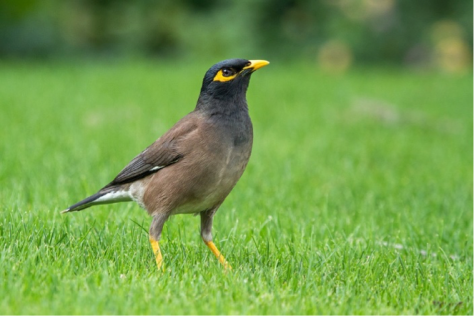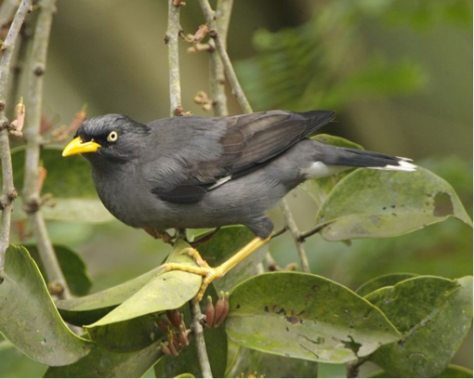Don’t worry, it’s not a typo error. It is true that Common Myna are not a common sight anymore, sadly. Common Myna are native to Asia, so you might wonder what happened to them. I’ll go into that soon but before that, let me introduce you to them!

Common Myna (Acridotheres Tristis) by smarko on pixabay https://pixabay.com/en/common-myna-acridotheres-tristis-1367119/
“Wait, isn’t this the bird I see all over Singapore? I’m sure I see some in my neighbourhood. Who says it’s not common?”
Did that thought come to your mind? I honestly won’t be surprised if it did because I thought the same way too, but no! These birds are different from the one you see around which are the Javan Myna.
Let’s spot the differences between the Common Myna and Javan Myna!

Javan Myna (Acridotheres javanicus) from Wikipedia https://en.wikipedia.org/wiki/Javan_myna
Have you spotted the stark difference? Take a closer look at its eyes. You would have noticed that the skin near the eyes of the Common Myna is yellow. To me (someone who isn’t a bird person), that is one way to differentiate between these two birds. Or you could take a closer look and realise that the Javan Myna is mainly black in colour while the Common Myna is actually a dark brown. But then again, birds move, and I’m pretty sure black and dark brown are not very easy to tell apart from a distance, so let’s stick with the yellow skin around the eyes.
Now that we have learnt how to tell these 2 birds apart, would you have wondered if these 2 similar looking birds with similar names have a special relationship? Well, yes, they do! But it’s somewhat like a “you go, I stay” kind of relationship. Remember when I said that Common Mynas were actually uncommon in Singapore? Well, they were common once, until the Javan Mynas came and took over, becoming the ‘common’ mynas we see in Singapore today. How did the Javan Mynas do that? They have found ways to adapt to the urban landscape of Singapore where they can build their nests anywhere (Meng, 2011) and feed on not just insects and fruits but also, our leftover food (Yap, 2002).
Such braveness in “hunting” for food and resourcefulness in ways of survival have led Javan Myna to become one of the, if not the most common bird in Singapore. Singapore is indeed a competitive society and we all need the right attitude to survive, be it humans or animals!
Here’s a fun fact: the International Union for Conservation of Nature (IUCN) listed Common Myna to be the 3rd most invasive species in the world (Yangchen, 2016) although the situation in Singapore is the exact opposite!
References
Meng, A. L. (2011, April 21). Lessons from two Mynas. Retrieved from Stir-fried Science: https://blog.science.edu.sg/2011/04/21/lessons-from-two-mynas/
Yangchen, L. (2016, April 22). The javan mynah: Today’s pest, tomorrow’s food? Retrieved from The Straits Times: https://www.straitstimes.com/singapore/environment/the-javan-mynah-todays-pest-tomorrows-food
Written by: Thang Hui Lin








